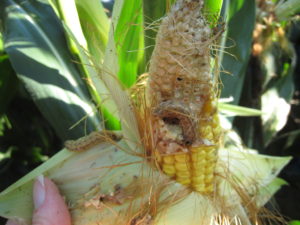Some corn fields may be at risk of extended WBC feeding this fall, particularly those that were late planted or are situated where egg laying occurred over a wider window. This year in particular, we are seeing a wide range of larval sizes because of the extended egg laying period that took place across much of the province. Fields that are maturing quickly may be less at risk, as the larvae will be dropping down to the ground to overwinter as the ears dry down in these fields.
 Though we know there were hot spots this year, including Bothwell to Strathroy and south of Tillsonburg, we encourage all corn producers to be scouting for ear damage over the next month. Scouting will identify additional areas that had decent WBC pressure and are at risk of higher overwintering populations and therefore infestations again next year. Scouting will also help in deciding whether to harvest the crop earlier, or to segregate grain from those fields to reduce risk of ear rot and vomitoxins.
Though we know there were hot spots this year, including Bothwell to Strathroy and south of Tillsonburg, we encourage all corn producers to be scouting for ear damage over the next month. Scouting will identify additional areas that had decent WBC pressure and are at risk of higher overwintering populations and therefore infestations again next year. Scouting will also help in deciding whether to harvest the crop earlier, or to segregate grain from those fields to reduce risk of ear rot and vomitoxins.
Fields in the Bothwell area are seeing significant ear damage already. Even fields planted to Herculex or SmartStax Bt corn that contain Cry1F are seeing greater amounts of damage than growers were expecting. These Bt hybrids provide only approximately 70 to 80% control, so under heavier pressure, the damage can be significant.
Focus on later planted fields first. Scout random areas of each field. Look at 10 consecutive ears in a row. You might see frass at the ear tip or a hole along the side of the husk where the larva entered. Peel back the husk and determine if larvae are present and make note of how extensive the feeding damage is. Birds diving into fields is also a good indication that WBC is present and unfortunately they will also contribute to the ear damage. Once the larvae reach the 6th and last instar, they drop to the soil and tunnel down deep to overwinter there. If larvae are nowhere to be found in the field, it is a good indication that they have already started to get ready to overwinter.
Hopefully we experience a warm and reasonably dry fall to help mature the crop quickly and avoid ideal weather conditions that promote further ear rot development.